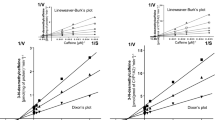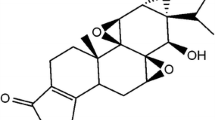Summary
We examined the inhibitory behavior of theophylline oxidations and a variety of cytochrome P450 (P450)-dependent metabolism in the presence of mexiletine (MEX), using hepatic microsomes from both control mice and mice exposed to β-naphthoflavone (β-NF). Theophylline metabolism, which is mainly catalyzed by CYP1A2, was susceptible to competitive inhibition by MEX. The calculated inhibition constants (Ki) for theophylline 3-demethylation and its 8-hydroxylation were 4.3 μM and 8.3 μM, respectively, which are comparable to the recommended therapeutic serum range for MEX. The inhibitory potency of MEX on cytochrome P450-dependent enzyme activities diverged among the several metabolic reactions, which were probes for CYP1A, 2A, 2C, 2D, 2E, and 3A subfamilies. The Ki value (6.7 μM) for methoxyresorufin O-demethylation mediated by CYP1A2 agreed with those from theophylline oxidations. These metabolic reactions exhibited the smallest Ki values, 1–3 orders of magnitude lower than activities of other constitutive cytochrome P450 species. Similar degrees of inhibition were observed in CYP1A1, a β-NF-inducible isoform with a relatively high conformity to CYP1A2. These results indicate that MEX acts as a selective and potent inhibitor of the CYP1A enzymes responsible for oxidative biotransformation of chemicals such as theophylline. This evidence provides a fundamental explanation for the pharmacokinetic interactions experienced in clinical practice.
Similar content being viewed by others
References
Beckett A.H., Chidomere E.C. (1977): The distribution, metabolism and excretion of mexiletine in man. Postgrad. Med. J., 53: 60–66.
Stanley R., Comer T., Taylor J.L., Saliba D. (1989): Mexiletine-theophylline interaction. Am. J. Med., 86: 733–734.
Ueno K., Miyai K., Seki T., Kawaguchi Y. (1990): Interaction between theophylline and mexiletine. DICP, 24: 471–472.
Loi C-M., Wei X., Vestal R.E. (1991): Inhibition of theophylline metabolism by mexiletine in young male and female nonsmokers. Clin. Pharmacol. Ther., 49: 571–580.
Grygiel J.J., Miners J.O., Drew R., Birkett D.J. (1984): Differential effects of cimetidine on theophylline metabolic pathways. Eur. J. Clin. Pharmacol., 26: 335–340.
Robson R.A., Matthews A.P., Miners J.O.et al. (1987): Characterisation of theophylline metabolism in human liver microsomes. Br. J. Clin. Pharmacol., 24: 293–300.
Joeres R., Klinker H., Heusler J., Epping J., Richter E. (1987): Influence of mexiletine on caffeine elimination. Pharmacol. Ther., 33: 163–169.
Lowry O.H., Rosebrough N.J., Farr A.L., Randall R.J. (1951): Protein measurement with Folin phenol reagent. J. Biol. Chem., 193: 265–275.
Konishi H., Yamaji A. (1994): Measurement of theophylline metabolites produced by reaction with hepatic microsome by high performance liquid chromatography following solid phase extraction. Biomed. Chromatogr., 8: 189–192.
Dutton D.R., Parkinson A. (1989): Reduction of 7-alkoxyresorufins by NADPH-cytochrome P450 reductase and its differential effects on their O-dealkylation by rat liver microsomal cytochrome P450. Arch. Biochem. Biophys., 268: 617–629.
Aitio A. (1978): A simple and sensitive assay of 7-ethoxycoumarin deethylation. Anal. Biochem, 85: 488–491.
Morita K., Ono T., Shimakawa H., Wada F. (1984): The effects of H2-receptor antagonists and imidazole on testosterone hydroxylations in mouse hepatic microsomes. Chem. Pharm. Bull., 32: 4043–4048.
Reinke L.A., Moyer M.J. (1985):p-Nitrophenol hydroxylation. A microsomal oxidation which is highly inducible by ethanol. Drug. Metab. Dispos., 13: 548–552.
Nash T. (1953): The colorimetric estimation of formaldehyde by means of the Hantzsch reaction. Biochem. J. 55: 416–421.
Yamaoka K., Tanigawara Y., Nakagawa T., Uno T. (1981): A pharmacokinetic analysis program (MULTI) for microcomputer. J. Pharmacobio-Dyn., 4: 879–885.
Hendeles L., Weinberger M. (1983): Theophylline. A state of the art; review. Pharmacotherapy, 3: 2–44.
Stanley L.A., Adams D.J., Balkwill F.R., Griffin D., Wolf C.R. (1991): Differential effects of recombinant interferon α on constitutive and inducible cytochrome P450 isozymes in mouse liver. Biochem. Pharmacol., 42: 311–320.
Nerurkar P.V., Park S.S., Thomas P.E., Nims R.W., Lubet R.A., (1993): Methoxyresorufin and benzoxyresorufin: substrates preferentially metabolized by cytochromes P4501 A2 and 2B, respectively, in the rat and mouse. Biochem. Pharmacol., 46: 933–943.
Kimonen T., Juvonen R.O., Alhava E., Pasanen M. (1995): The inhibition of CYP enzymes in mouse and human liver by pilocarpine. Br. J. Pharmacol., 114: 832–836.
Morita K., Shimakawa H. (1992): Selective inhibition of hepatic microsomal drug-metabolism by mexiletine hydrochloride. Jpn. J. Hosp. Pharm., 18: 612–619.
Wei X., Loi C-M., Schmucker D.L., Vestal R.E. (1995): Characterization of the independent and combined effects of two inhibitors on oxidative drug metabolism in rat liver microsomes. Biochem. Pharmacol., 49: 1657–1663.
Ogiso T., Iwaki M., Uno S. (1995): Inhibition kinetics of theophylline metabolism by mexiletine and its metabolites. Biol. Pharm. Bull., 18: 75–81.
Wei X., Loi C-M., Jarvi E.J., Vestal R.E. (1995): Relative potency of mexiletine, lidocaine, and tocainide as inhibitors of rat liver CYP1A1 activity. Drug Metab. Dispos., 23: 1335–1338.
Ogilvie R.I. (1978): Clinical pharmacokinetics of theophylline. Clin. Pharmacokinet., 3: 267–293.
Zhang Z-Y, Kaminsky L.S. (1995): Characterization of human cytochromes P450 involved in theophylline 8-hydroxylation. Biochem. Pharmacol., 50: 205–211.
Ha H.R., Chen J., Freiburghaus A.U., Follath F. (1995): Metabolism of theophylline by cDNA-expressed human cytochromes P-450. Br. J. Clin. Pharmacol., 39: 321–326.
Konishi H., Morita K., Yamaji A. (1995): Multiplicity of cytochrome P-450 species involved in theophylline metabolism in mouse hepatic microsomes. Biol. Pharm. Bull., 18: 576–580.
Konishi H., Morita K., Yamaji A. (1996): Involvement of CYP2E in 8-hydroxylation of theophylline in mouse hepatic microsomes — difference from its N-demethylations. Biol. Pharm. Bull., 19: 593–598.
Rohrig T.P., Harty L.E. (1994): Postmortem distribution of mexiletine in a fatal overdose. J. Anal. Toxicol., 18: 354–356.
McManus M.E., Miners J.O., Gregor D., Stupans I., Birkett D.J. (1988): Theophylline metabolism by human, rabbit and rat liver microsomes and purified forms of cytochrome P450. J. Pharm. Pharmacol., 40: 388–391.
Lewis D.F.V., Ioannides C., Parke D.V. (1986): Molecular dimensions of the substrate binding site of cytochrome P-448. Biochem Pharmacol., 35: 2179–2185.
Shimada T., Yamazaki H., Mimura M., Inui Y., Guengerich F.P. (1994): Individual variations in human liver cytochrome P-450 enzymes involved in the oxidation of drugs, carcinogens and toxic chemicals: studies with liver microsomes of 30 Japanese and 30 Caucasians. J. Pharmacol. Exp. Ther., 270: 414–423.
Gonzalez F.J. (1990): Molecular genetics of the P-450 superfamily. Pharmacol. Ther., 45: 1–38.
Abolfathi Z., Pakdel H., Beaune P., Turgeon J. (1995): CYP1A2 is the major enzyme involved in N-oxidation of mexiletine (MEX) in man. Clin. Pharmacol. Ther., 57, 215.
Author information
Authors and Affiliations
Rights and permissions
About this article
Cite this article
Konishi, H., Morita, K., Minouchi, T. et al. Preferential inhibition of CYP1A enzymes in hepatic microsomes by mexiletine. Eur. J. Drug Metab. Pharmacokinet. 24, 149–153 (1999). https://doi.org/10.1007/BF03190360
Received:
Issue Date:
DOI: https://doi.org/10.1007/BF03190360




